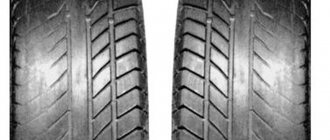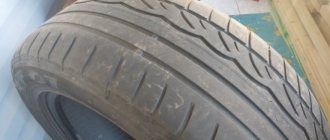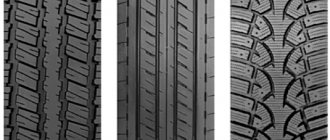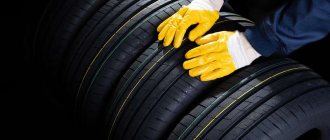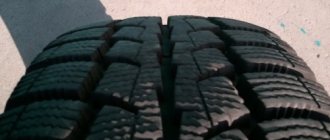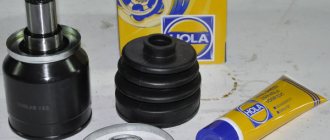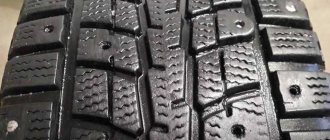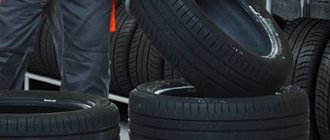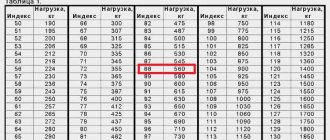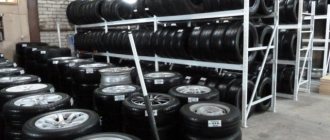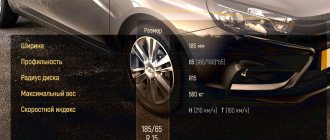Zigi › Blog › Types of tire wear and destruction
1. Failure to comply with the norms of internal air pressure in tires and their overload
2. Irregular maintenance and repair of tires
3. Violation of the rules for dismantling and mounting tires
4. Wheel imbalance
5. Malfunctions of the vehicle's chassis and steering
6. Overload (or underpressure) by 10% reduces mileage by 20%. One of the determining parameters when selecting tires is the maximum permissible load on the tire. It is recommended to use tires with a 10-15% margin for this indicator. Such tires will operate in more favorable conditions even with short-term overload.
7. Constant driving on gravel and crushed stone. On such roads, the wear rate is higher due to an increase in abrasive wear, which causes the formation of scratches, cracks, cuts, tears and tears in the tread rubber.
8. Frequent operation during prolonged driving on the highway at high speed. When driving for a long time at high speeds, tire deformation occurs more often. As a result of internal friction, energy is released, which is mainly converted into heat. There is intense heating of the rubber (especially in the summer). Friction on the road increases. An increase in temperature outside and inside the tire can lead not only to increased wear on the tread surface, but also to the occurrence of delaminations between tire parts. So, at a temperature of 120 degrees Celsius, the tensile strength of conventional rubber is reduced by 40%
9. Sports driving style (frequent and sharp acceleration and braking). An active driving style leads to the tread slipping in the contact patch, which significantly increases the wear rate, both during acceleration and braking. The higher the speed at which sudden braking begins, the more intense the wear. Prolonged emergency braking can lead to the formation of wear marks and even separation of tread elements.
Type of wear: 1 Rubber wear on both sides all around.
Cause: Tire pressure too low.
Type of wear: 2 Rubber wear in the middle along the entire perimeter. Cause: Tire pressure too high.
Reason: Incorrect adjustment of wheel alignment angles, as well as overcoming curved sections of the road at high speeds. In this case, to prevent further tire wear, rotate the tires on the rims or swap the front and rear wheels. Wear on the outer edges of the tire more than the center cross-section indicates that the vehicle has been driven for a long period of time with too low tire pressure.
Type of wear: 4 Abrasion in some places on the side of the working surface.
Reason: Lack of static and dynamic wheel balancing. There may be excessive lateral runout of the disc, too much play in the wheel bearings or suspension arm joints.
Reason: Lack of static wheel balancing. There may be excessive lateral runout of the rim.
Type of wear: 6 Heavy wear in some places in the middle of the working surface.
Cause: Consequences of wheel locking during sudden braking. It is also possible that the brake drum is oval shaped and is always in the same position when the wheels are locked.
Reason: Vehicle overload. Check the inside of the tire for cracks.
Wear Type: 8 There are sharp edges on one side of the front wheel.
Reason: Frequent driving on heavily broken road surfaces. Driving fast around corners.
Type of wear: 9 Frame base is torn. At first, this is only noticeable from the inside of the tire.
Reason: Driving on sharp stones, rail joints at high speed
"Bald spots" on the tire
If there are certain areas on a car tire that are more worn than the rest, they are usually called “bald spots” or spots. Most often, such spots appear on the cars of drivers who like to accelerate and brake sharply. During rare (including emergency) braking, if the car does not have an ABS system, the wheels are blocked and the car slips on the tire along the road surface. Sliding leads to an increase in tire temperature and immediate wear.
In addition, spots on your car's tires can appear if it sits idle for a long time. When parked for a long time, a separate section of the tire bears the entire weight of the car. Due to its structure, it can become deformed over time.
The main reasons for uneven tire tread wear
Car tires, like all parts in a car, have their own specific service life; as a rule, with careful use and normal quality, tires last from 4 to 6 years. But intensive premature wear of tires often occurs; as motorists say, it eats rubber. Tires can be “eaten” in different places on the tread; wheel wear occurs on both the front and rear axles.
It is not easy to say unequivocally why rapid tire wear occurs; sometimes it is difficult even for experienced drivers to find the reason. But in many cases, the “zhor” of tires indicates existing faults in the car that need to be corrected.
The main reasons why it eats rubber from the outside
Rubber on a car can be eaten both from the outside of the tread and from the inside; the main reasons for external intensive wear are:
- incorrect toe adjustment (the wheels are tilted in different directions more than they should be);
- the presence of play in steering rods and tips;
- factory defect of tires;
- high speed when cornering;
- insufficient tire pressure.
As a rule, when the outer part of the tread is intensively eaten away, the rubber emits an unpleasant squeak when entering turns. On many passenger cars, the tires on the front axle wear out first, since “burning” occurs when braking, and the load mainly falls on the front disc brakes.
Also, a hernia may appear on the outer side wall of the rubber, which occurs as a result of a side impact or falling into a hole on the road. It should be noted that a bulge on the tire does not always appear immediately; a hernia may be detected only after a week or even later. Cracks on the outside of a tire most often appear for two reasons:
- the car has been operated for a long time with low tire pressure;
- The tires have exhausted their service life, it’s time to replace them with new ones.
Another option is uneven wear on the outer part of the tread along the radius; some kind of bumps appear on it. The main reason for the occurrence of such a defect is a faulty suspension; broken shock absorbers are primarily to blame for this.
Eats rubber from the inside on VAZ-2101-07 cars
On any car, the tread on those wheels that are driving wears out first, so on all rear-wheel drive VAZs, the tires on the rear axle are eaten up more intensively. The main reasons for the intensive wear of tires on the “Classic”:
- the geometry of the body is broken (usually after a blow to the rear);
- bent “stocking” (housing) of the rear axle;
- jet rods are faulty (bent, bushings are broken);
- crooked rims;
- Wheel alignment is not adjusted.
Uneven wear of the tread of one of the tires on an axle can occur due to different pressures in the tires, for example, in one wheel there is 1.5 Atm, in the other - 2 Atm.
The cause of tire burn on the front axle of a VAZ is often faulty silent blocks; here the internal bushings can become dislodged or broken. Also, rubber often wears out due to an impact on the wheel (falling into a hole at speed), in which case the tire on the side of the axle where the damage occurred is “eaten” more intensely.
The same problems with tread wear are observed on Niva cars, since the suspension of this model is structurally almost the same as on the VAZ-Classic.
Suspension faults
With increased wear of suspension parts, wear of the tires is often observed. If rubber bands, silent blocks, or levers are damaged, their position relative to each other changes. The wheel alignment angles will change accordingly. Often, after diagnostics, services recommend carrying out chassis repairs before making adjustments. Do not forget that wheel alignment can also be influenced by steering arms.
Tire wear can also occur due to problems with body geometry. In this case, the position indicators of the associated suspension parts change. The fact is that with a strong impact, the body changes its shape. This can happen even when driving sharply through a pothole. The complexity of the situation lies in the low visibility of such damage with the naked eye. This can only be revealed at a specialized stand. Work is also being done to rectify the situation. In general, it is recommended to visit such a stand once a year, especially with frequent trips on primers.
Conclusion
. As a rule, problems with tire wear begin quite unexpectedly. At the same time, not every master will be able to correctly identify the cause. That’s why it’s important to know why a car eats rubber on the outside and inside of the front wheels. Having this skill, you will be able to independently find the cause of the malfunction, well, with the exception of moments when it is necessary to take measurements. You can’t do this without visiting a car service center.
| Camber | Increases the area of the tire contact patch with the road |
| Convergence | Compensates for the elastic movement of suspension parts (silent blocks and other rubber bands) |
| Custer | Helps return the steering wheel to its original position |
Why does it eat rubber on the inside and outside at the same time?
It often happens that the rubber is “eaten up” on both sides of the tread at once; as a rule, in this case the car does not pull to the side, it drives straight. If this happens, most often the “to blame” is low pressure in the wheels, when the tread pattern wears out only in the middle - the car is constantly operated with tire pressure above normal.
Another option is that the inner part of the tread is “eaten up” on one front wheel, and the outer part on the other. In this case, most often the cause of the defect is incorrect wheel alignment adjustment, but on some car models the wheel alignment is not adjustable, for example, on Gazelle cars. On cars produced by GAZ, the camber is set from the factory, and a factory defect cannot be ruled out here. Another “culprit” of the malfunction is a worn hub bearing; its diagnosis should be carried out with the wheel hanging.
Which tires, according to car enthusiasts, are more or less wear-resistant?
- "Consider your needs." “One tire manufacturer produces tires for different road conditions.
For example, they were installed on my ITP terracross car. These wheels are good for driving on gravel roads and over rocks. However, the rubber is too hard, it does not flatten completely, even if the wheels are lowered a little. It is clear that in winter these tires are completely plastic, you don’t even need to inflate them. But the stock ones on the Polaris (Dunlop, it seems) are quite soft, especially if you lower them a little; in the winter, they row well even on a snowy track. But the sidewall is weak, cuts appear constantly. So before you buy a set of wheels, find out what they are for and take that into account when purchasing.” - "I speak from experience."
“If the pressure is 0.25–0.4, any rubber quickly wears off on the asphalt. When the pressure is 1.2–1.5, the Mudlights will walk for a long time, even on asphalt surfaces. Terocross tires practically do not wear out. But if you drive through mud, it doesn’t matter what kind of wheels, they won’t wear out. However, even ITP has a special “Mega Mayhem” mud tire, which is superior to “Mudlight” in durability. Many people say that Diston wears less, because it is quite tough. But I think there is no difference.”We recommend
“The car smells like burnt rubber: 3 possible reasons” Read more
- “There are no perfect tires.”
Hankook tires are the toughest and most abrasion-resistant tires, especially if you drive a lot. Therefore, for budget-conscious car owners this is what they need. My friend has Maxis, they developed lateral hernias after a season of use. Therefore, you need to select tires that meet your requirements for resistance to wear, aquaplaning, mud grip, comfort and noise level while driving. There is no perfect tire that will suit every driver’s needs.” - “Chinese tires? Why not?".
“You shouldn’t think that Chinese tires are bad. After all, almost all wheels are made in China, even if the tires are from a well-known brand. My brother sells car tires, he says that tires from any, even the most reliable manufacturing company, can be made in China, and this will not be indicated on it.” - “I like Korean-made tires.”
“I have always preferred wheels made in Korea. Although now the car is equipped with Chinese Hankook Ventus Preme K105. I just couldn’t choose which was better when purchasing: Hankook K105 (China) or K114 (Korea). The first ones liked the drawing better. I skated for two years, everything suits me. The price is reasonable for this size - within 3,700 rubles. New Hankook K110 have appeared, I’m thinking of buying them. I also liked the MAXXIS visually: MA-Z1, i-PRO, MA-Z4S, MA-E1, MA-V1, M-35.” - "The best tires!"
“I used to have NEXEN, medium tires. In one season, due to incorrect geometry, the wheels wore out. Then I bought AMTEl, I don’t recommend it to anyone. Although the tread has not worn off, bumps and hernias have appeared on the wheels, and on all tires at once, the steering wheel moves from side to side. But the wheels came off after 3.5 seasons. Maybe they just got too old. Now I'm riding NOKIAN HAKKA GREEN - these are my best wheels. There is complete silence in the cabin, the car drives smoothly. I drove it for one season, I recommend it. Although many say that such wheels deteriorate due to gravel, the rubber wears off immediately. But I won’t say anything about this – I just don’t know.”
Why you need to pay attention to tire wear when buying a used car
If you are buying a used car, during the inspection it is important to pay attention to the condition of the tires; they can tell a lot (of course, if the tires are not new). As mentioned earlier, uneven tire wear can mainly be caused by the following reasons:
- Tire pressure is incorrectly adjusted.
- The wheel alignment angles are set incorrectly.
- There are faults in the suspension - there is play in the tie rods/tips, the silent blocks are worn out, the arms are bent, the shock absorbers require replacement, and so on.
- Wheel rims are deformed, causing imbalance.
- The geometry of the body is broken.
If the first four points are quite easy to deal with, and the cause of the malfunction can be eliminated, then with a violation of the geometry everything is more complicated; it may be violated as a result of a serious accident, and in this case it may not be possible to correct anything. Therefore, before buying a car with unevenly worn tires, you should ask the real owner to diagnose the car at a service station, and only after making sure that the body is in normal condition should you carry out the purchase and sale transaction.
How to determine tire wear
Some car owners wonder how to know when it's time to install a new set of wheels? First you have to learn how to determine how worn they are. Not every driver knows how to do this. Therefore, dangerous situations occur when the tires are completely worn out on the track or while traveling. There are several ways to determine if tires need urgent replacement. Let's look at each of them in more detail.
Visually
The easiest way to determine the suitability of tires is to conduct a visual inspection. However, no one guarantees that the results obtained will be 100% accurate.
Tires must be replaced if, during a visual inspection, you find that:
- the wheels have cuts, cracks and other defects;
- the tread is worn unevenly, one part of it is intact, the others have worn away so much that the cord is visible;
- The rubber has worn off from the inside. This may happen because it comes into contact with any part of the car and wears off;
- there are bumps on the tires. This indicates that the wheels are worn out and need to be replaced.
- Measuring the tread height
To find out how badly the wheels are worn and whether you need to buy a new set of tires, you will have to get a caliper. It makes it easy to determine the tread height. Of course, you can also use a ruler with a depth gauge or other device. How can you find out what the tread thickness is in millimeters and how worn the tires are? To do this, take measurements in several places, because tires can be worn unevenly.
If you are convinced that the tread height meets the manufacturer's recommended values, then the tires can continue to be used. Otherwise, you should install a new set of wheels as soon as possible. After all, driving on worn-out tires can lead to irreparable consequences, especially in extreme road situations.
According to wear indicator
Many tires have a special indicator that shows how worn the tire is. Is it at the same height as the tread? This means that the wheels need to be replaced as soon as possible, because they are worn out. Most often the indicator has 4 digits. On summer tires, the permissible wear is up to 2-3 mm, on winter tires - up to 4-6 mm.
Don't forget that winter wheels may have studs. When 60% of them have fallen off, it means that the wheels have become unusable. After all, without studs, winter tires will not be able to provide the required grip on the road surface.
The importance of correct tire pressure
Tires are inflated to a certain pressure so that the car can drive smoothly on the roads and maintain its weight. If the pressure is incorrectly set, fuel consumption increases, tires wear out prematurely, and the car handles and brakes worse.
The statement that on any passenger car you need to inflate tire pressure to 2 atm is incorrect; for each car the manufacturer sets its own parameters, usually they are indicated on the central pillar of the car on the driver's side, and information can also be marked on the gas tank flap from the inside.
When measuring with a pressure gauge, it is important to take into account that in warm weather the pressure in the tires increases, so you need to inflate the wheels in accordance with the season and the temperature at which the car is operated. And measurements must be taken at least once every three months, and before each trip the condition of the tires should be inspected.
Tire dents
Even the rubber surface of tires can become covered with small dents that change the shape of the tire and render it unusable for use.
The edges of the tires form bumps and depressions, and this is due to problems with the suspension. When driving on the road, the car constantly jumps and falls, and the suspension must absorb the impact of the tires on the road surface so that they do not develop dents. If there are problems with the suspension or chassis, the cushioning of impacts on the road surface may not be sufficient.
Not every driver can carry out a complete diagnosis of the suspension and chassis of a car on their own. That is why in such a situation it is better to contact specialists or try to replace the shock absorbers. In most cases, they are to blame for the appearance of dents on the tires.
Premature wear or eating rubber on the car from the outside front: treatment
Critical adjustments
The front suspension is a complex mechanism, but adjustable. Therefore, if you are eating tires from the inside of the front, you must first analyze its current settings. And premature wear of the outer shoulder is also a reason to inspect the relative position of the front suspension arms.
This chassis design is designed not only to optimize tire wear resistance. First of all, other goals are pursued - increasing the stability of the car and ensuring easy handling. In the adjustment process, it is customary to distinguish between three types of parameters:
- Camber is the angle between the longitudinal plane of the wheel and the vertical axis or the position of the wheels in relation to the road surface. Affects the area of the contact patch with the road. Preferably a negative value.
- Toe-in is the position of the tires relative to the horizontal plane. Required to compensate for the elastic movements of rubber parts when transmitting traction to the wheels.
- Caster is the angle of inclination of the transverse vertical plane of the wheel relative to the vertical axis. Needed to ensure self-return of the steering wheel when exiting a turn.
What to do if you eat rubber from the inside front: possible reasons
A non-standard situation often occurs in the form of different wear on tires mounted on the same axle. Let’s say the right wheel “ate” from the outer end, the left one from the inner end. The exact reason is an incorrectly performed operation to adjust the geometry of the relative position of the suspension elements.
The real reason
The list of actions in the case of rubber eating on the outer side in front is partly relevant when identifying rapid wear of the inner shoulders. When identifying increased abrasion of the treadmill from the inner edge, the nature of the malfunction should be classified into one of the following groups:
- The side checkers are erased evenly - the camber angle is adjusted incorrectly.
- Saw-tooth herringbone wear – toe-in is not up to standard.
Options for combining the fixed types of worn tread geometry cannot be ruled out. Under such circumstances, experts talk about incorrect settings for both camber and toe. For your information. Not all vehicles provide the ability to adjust all three wheel angles. If there are defects and there are no necessary adjustments, the cause should be sought in non-original and worn suspension components (silent blocks and other bushings). Factory defects in tires or incorrect adjustment of landing gear levers should not be discounted.
There are often cases when the rear “eats” rubber on one of the sides. Worn rear suspension silent blocks are a likely cause of the malfunction. However, tuned struts and various types of spacers can also cause deviations in the geometry of the tires used.
Verdict
Possible malfunctions causing uneven tread wear are:
- Eats rubber from the inner edge. If there is a “herringbone” pattern on the treadmill, the problem is incorrect alignment; Even wear is due to a false camber angle.
- It eats rubber from the outer end - positive camber is to blame.
The wheel alignment settings are within tolerance - see the following:
- There is wear on the rubber suspension components.
- The correct shape of the rack flanges.
- Compliance of the design of support bearings and various spacers with the requirements of the manufacturer.
Asymmetrical geometry of the working part of the tire can also be caused by a damaged body. Another probable cause is noticeable play in the hub bearing.
Current issues
Why does the wheel alignment go wrong?
A bad road has a negative impact not only on the life of chassis components. It also leaves a negative imprint on their mutual position. Timely control of adjustments is necessary in the following cases:
- After a strong impact on the curb, holes, potholes and other uneven road surfaces.
- Upon completion of replacement of suspension elements.
Attention! Wear on the consumable components of the suspension structure also disrupts the installation angles.
The components are original and the wheel alignment is correct: the tire still wears unevenly
It is likely that the hub bearing has become unusable. If there is such a malfunction, it is difficult not to notice the play by rocking the wheel in different directions. While it is possible to deal with this ailment, it is difficult to change the incorrect geometry of the body. And due to the bent load-bearing part, there may well be rubber on the inside of the back or front of the car.
Premature wear does not meet the above criteria
Cases of asymmetrical “eating” of rubber products are discussed above. The following cases of tread wear should be classified as symmetrical:
- On both sides: low tire pressure.
- Center: increased tire pressure.
There are often situations when on the front/rear axle one of the tires works faster than the other. The only argument in favor of this state of affairs is the different pressures in tires located on the same axle. As a result, the car pulls to the side and there is increased friction in the wheel with less air.
The problem is definitely not wheel alignment.
- Eats rubber around the edges. There is only one reason for this: the tire has low pressure.
- The tire was eaten in the middle. This happened because she had high blood pressure.
- On one axle, the right tire wears out faster than the left, or vice versa. Due to the difference in pressure between wheels located on the same axle, the car is pulled to the side with a tire with a reduced air volume. The same cylinder experiences additional frictional force, which causes it to wear out faster.
- The wheels wear out in bumps. Occurs due to imbalanced balancing, resulting in lateral runout of the disc.
If the suspension parts are not deformed, the consumables are fresh, the angles are within tolerance, the tires are new, and the balanced wheel still wears unevenly, check the body geometry. There are plenty of cases when even after a minor accident there was a problem with one of the tires.
Tires are consumable and seasonal material. It is difficult to theoretically predict the degree of wear depending on mileage. Almost everything depends on the rubber composition of the mixture. By year, the average service life is about 5-6 years. This is the limit after which the product will develop cracks, and if there are cracks, there is a high risk of getting into a dangerous situation. However, the tire may lose its proper appearance much earlier.
